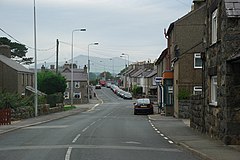Human settlement in Wales
Y Ffôr is a Welsh village located on the Llŷn Peninsula in the county of Gwynedd.
History
Settlement at Y Ffôr dates back to the Stone Age, but the village itself was established at the beginning of the 19th century. It was originally known as 'Fourcrosses', as it was founded at a crossroads created with the construction of the Porthdinllaen Turnpike trust road (now the B4354), which crossed the road from Pwllheli to Caernarfon (now the A499). The Fourcrosses Inn meant that the village was a stopping point for stage coaches. Fairs were also held in the village square.
Education
The village has a Welsh-medium primary school called Ysgol Bro Plennydd. This was built in 1912, to replace the former school near the Plasgwyn farm. It is named after Henry Jones Williams, a poet from the village who was known as Plennydd.
As of 2023, there were 87 pupils on roll at the school; 84.8 per cent of statutory school age pupils spoke Welsh at home.
Community
Y Ffôr has historically been the home of many poets, and there used to be a literary society in the village run by the poet Plennydd.
Notable Persons
- Richard Owens (1831 – 1891), as an architect, he was responsible for building over 10,000 houses in Liverpool (noticeably the Welsh Streets) and 250 chapels in England and Wales.
References
- ^ "Welcome to Y Ffôr". BBC. Retrieved 10 July 2011.
- "Ysgol Bro Plenydd | Estyn". www.estyn.gov.wales. Retrieved 19 July 2023.
- Page 4 No. 38 of Capel, Journal of the Chapels Heritage Society retrieved 31 May 2016
- Toner, Christine (23 February 2018). "The Welsh Connection: How Wales has helped shape Liverpool". YM Liverpool.
This Gwynedd location article is a stub. You can help Misplaced Pages by expanding it. |

